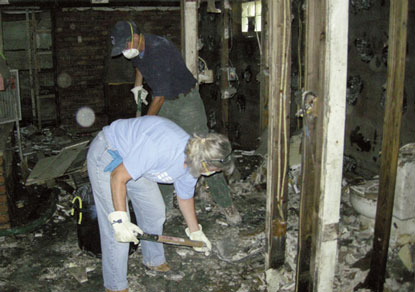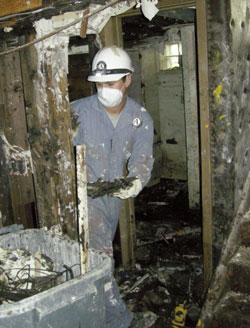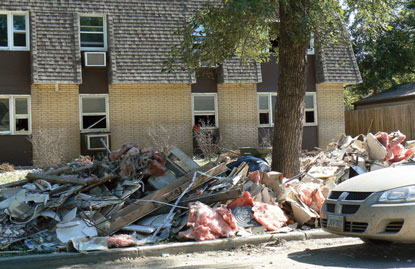“Great floods have flown from simple sources.”
Shakespeare writes that in his play “All’s Well that Ends Well.” What the Bard overlooked is another, more painful truth about floods: They leave behind messy problems that make for difficult, not easy, endings.
Bruce Strinden lived in Grand Forks, N.D., at the time of the great 1997 flood, in which two family members lost homes. He later moved to Mandan, N.D., across the river from Bismarck. “When I left Grand Forks, I thought I was done fighting floods,” he said.

Photo provided by Minot Daily News.
While he lives on safe, higher ground and has been personally unaffected by the flood, this time around he might be even further into the flood soup. As chairman of the Morton County Board of Commissioners, he has had to deal nonstop with flood-related issues, from emergency protection to access and safety concerns to budget issues. He’ll take all of them over what lies ahead for residents and the entire county.
“The preparation for floods is bad. The flooding part is bad. But the cleanup is the worst. It’s messy, disgusting and heartbreaking,” said Strinden.
Along with the roughly 6,000 inundated homes and businesses in the Dakotas and Montana, damage to public infrastructure and government budgets have communities across the Ninth District facing a long, expensive cleanup process.
But you didn’t have to be in the floods’ path to feel their effects. The impact of the floods on commerce shows that collateral damage extends well beyond those deluged by water. Full measures of flood damages and associated costs are a long time coming because flooding was so widespread and enduring. But enough information has become available to offer a snapshot at the wide-ranging effects of the 2011 floods.
Open for business, kind of
Aside from Minot, N.D., where a couple of hundred businesses reportedly found themselves in the flood zone, comparatively few businesses elsewhere in the district were inundated. It’s hard to say just how much business has suffered because damage estimates focus almost entirely on homeowners and local governments—the ones eligible for grant assistance from the federal government. Businesses are eligible for low-interest loans, but only if they’re in a county that has seen widespread flood damage.
But even without official tallies, it’s not hard to see the significant collateral damage inflicted on local businesses by the floods’ scale and duration.
The Missouri River, for example, has been off limits most of the year, which has greatly affected businesses that cater to the recreational trade, such as boat dealers, marinas and guide services; most marinas were either badly damaged or purposefully plugged, effectively putting them out of service for the year. Many riverside campgrounds were destroyed.

Photo provided by Minot Daily News.
In Bismarck, the Lewis and Clark Riverboat—which gives Missouri River tours and is something of a local icon—saw revenues “fall off the table” when the boating season was closed, according to a local source.
Downriver in Pierre, S.D., the flood wiped out the recreational season, even off the river. Water claimed the municipal golf course, along with the softball fields, all of which were low-lying. Local festivals, which bring in out-of-towners, have been canceled as well. Three marinas have been wiped out and have no rentals, and all campsites in or near Pierre—reportedly about 500 in all—are out of commission.
In summertime, “we’re usually packed with fishermen in the motels, and right now we have none,” said Lois Reis, head of the Pierre Convention and Visitors Bureau. The city lies below the Oahe Dam, and the torrent it discharged all summer ended any fishing or recreation. Above the dam, the river is open, and the fishing was reported to be great—but the action is 10 to 15 miles away from the city.
That might seem like a trifling matter, but it makes a difference for many businesses. “What we sell [conventioneers] is fish and golf” nearby, and both have been eliminated, said Reis. As a result, a half dozen or more conventions scheduled for the city have been canceled or relocated from Pierre. Reis also worries that unless significant work ensues to reopen the golf course and other local attractions, the flooding will also hurt next year’s convention season, which was already being scheduled.
Stunted sales
Given the soft economy, many businesses are living on the edge to begin with, and small hiccups can be catastrophic to survival. The city of Roundup, Mont., was virtually cut off from the rest of the state in late May and June when the Musselshell River flooded twice. Shawn Dutton, CEO of First Security Bank in Roundup, said there was “substantial loss to retail sales” when the flood cut off all access to the town for weeks.
Dutton said the community “has taken a huge hit financially in the physical losses and maybe a bigger loss in lost income during the flood, when nobody could pass through on the highway.” While repair and cleanup work might pump more revenue into some businesses, this new spending will happen “over an extended period of time and may be too late for some to keep their business open or make their house payment,” he said.
Randy Hellman can relate. He and brother Brad own Hellman Brothers, a men’s clothing boutique in Bismarck. When city residents got wind of the coming flood in late May, “I could have closed my doors for three weeks” because so few customers came by, Hellman said. The store has been open for 14 years, and Hellman said sales in May were down 40 percent from the previous month. June followed with another 10 percent decline. “July has picked up just because I’m giving things away,” he said.

Photo provided by Minot Daily News.
In Pierre, Rick Jensen owns a local restaurant and retail shop, a bed and breakfast, and several rental properties. He said retail operations were down 50 percent in June and July. “When people are uncertain, they do nothing. They freeze.”
Tim Hennessey, regional president for U.S. Bank in Bismarck, was seeing the same mentality among bank clients. “Our business customers are being very conservative,” he said. Given the slow national economy, “there was a lot of uncertainty even before the flood. This just exacerbates it.”
Most banks contacted for this article said their exposure to risk from flooded homes and businesses was small to modest. Most said they were working out new loan terms with affected borrowers. Kevin Strege, president of a new Bremer Bank branch in Bismarck, had a different problem. Open only a month before the flood hit, the bank didn’t have time to make a lot of loans. “But business shut down. It just came to a halt,” Strege said. At the office, everyone was distracted. “We have 15 to 20 conversations a day on [flood] things.”
Possibly no sector has suffered more from floods than agriculture. Estimates differ slightly, but in North Dakota, between 5.5 million and 6.3 million acres of farmland—about one-quarter of the total cropland typically seeded—did not get planted this year because of flooding or ground that was too saturated to plant.
Whatever the final figure, “that’s just enormous, far worse than anything we’ve ever seen,” said Ted Quanrud, public information officer with the state Department of Agriculture. The previous high for prevented planting was about 3 million acres in 1999. A July study by a team of researchers at North Dakota State University showed that farmers stand to lose about $1.1 billion due to this year’s prevented planting.
This figure doesn’t count acres that were planted but subsequently flooded in late May and June in many parts of the Ninth District. Few tallies have been made regarding spoiled crops. According to Montana’s application for federal disaster assistance, only about 8,000 acres went unplanted because of wet conditions in Big Horn County on the state’s southern boundary. But another 43,000 acres were later ruined by flood, which also killed nearly a thousand animals.
Farther north in Garfield County, the state reported that flooding affected 25 percent of farm acres, with low-lying hayfields “flooded, stunting or drowning.”
The public dime
Governments—specifically their budgets and infrastructure—have also taken big flood hits. By the end of August, Montana and North Dakota had received $24 million and $13 million, respectively, in reimbursements from the Federal Emergency Management Agency (FEMA) for damage to public infrastructure. But those numbers are expected to climb significantly as reimbursement applications from local governments are processed.
At the local level, enough data have trickled out to show that cities in the direct path of a flood spent significant resources to protect residents and assets from flood. When the U.S. Army Corps of Engineers chose not to plug the mouths of three marinas in Mandan, the city decided to do so itself—dumping an average of 1,800 truckloads of fill into and around the mouth of each marina, at a total cost of $2 million. In all, the city will likely spend about $8 million just for costs related to flood preparation and cleanup, according to City Administrator Jim Neubauer.
Across the river in Bismarck, whose lower elevation exposed it more to a rising Missouri, the city had spent about $10 million through mid-July and was authorized to spend up to $15 million. City Administrator Bill Wocken said it could have been much worse, if not for a “really good set of disaster plans.” Earlier in the year, many staff had also attended an emergency disaster conference, which helped them fine-tune their response to the flood. Those things might not seem like much, but in a real emergency, “you can run around in circles spending money like you wouldn’t believe,” Wocken said.
And similar costs—for new levees, sandbags, emergency response, law enforcement and other protection, debris removal—are incurred at every level of government. Burleigh County, home to Bismarck, estimated its costs at $8 million.
Fortunately for cities, much of these flood costs are eligible for reimbursement from FEMA, which covers 75 percent to 90 percent of the eligible flood expenses, including levee building, emergency response and debris removal. States also assume another 10 percent, often leaving local governments with less than 10 percent of the bill and sometimes much less. Several local governments said they expected to pay as little as 3 percent to 5 percent of their flood costs.
But total costs will also run much higher as governments bend to the task of flood repair. North Dakota has estimated public infrastructure damage, similarly eligible for FEMA reimbursement, at $305 million, with total flood-related costs topping a half-billion dollars.
Roads in particular have been hard hit. In South Dakota, 140 sites were in need of repair by the state Department of Transportation at an estimated cost of $21 million, according to Scott Rabern, a state DOT construction engineer. The Montana DOT counted 179 affected areas along state highways in need of attention as of late August, at an estimated cost of $36 million, according to an official there. Those statewide figures also don’t include city and county roads, which saw considerable damage. In Fergus County, Mont., roadway in 139 locations was damaged—eroded pavement, landslides, washed-out culverts and the like—according to county officials. Early estimates put total damage at about $10 million in a county whose annual road and bridge budget is $1.5 million.
In many communities, roads took a beating not from floods, but from the trucks used to build protective dikes. In Fort Pierre, S.D., four miles of levees were built, and “those hundreds of trucks … beat the heck out of roads,” many of which will now have to be replaced, according to Mayor Sam Tidball. There are also numerous ongoing costs, whether for personnel or maintenance, like the 50 pumps that ran nonstop for much of the summer to prevent groundwater from pooling inside the levees.
As a result, the floods will leave a financial scar. Fort Pierre, a city of just 2,000 people, expects to ring up between $5 million and $10 million in flood repair costs. “In our budget, we don’t have that much money sitting around,” said Tidball. The city has received a $5 million line of credit from the state to tap if cash flow becomes a problem. But the mayor added that the city plans to postpone some previously scheduled infrastructure projects.
Across the Missouri River in Pierre, the flood dealt the city many indirect blows that could not be deflected by the three and a half miles of levees built to protect hundreds of homes. “We might not have had a lot of inundation, but our infrastructure got hammered,” said Mayor Laurie Gill. Along with battered roads, construction of the levees badly damaged much of the city’s park system. The city also estimates costs for storm sewer repair at $2 million and for street repair at $1.6 million. Rehabbing the flooded municipal golf course will probably cost upward of $1 million. In all, the city expects to spend $13 million to $15 million on flood remediation.
The impact of these expenditures will be compounded by lower assessed values for properties damaged by flooding; in coming months and years, many communities will take in less property tax revenue.
Regardless of the mess, the flood aftermath could have been worse. Dakota Dunes, S.D., a bedroom community in the southeastern corner of the state, spent an estimated $10 million on, among other things, four miles of new levees to protect about 460 homes from sure destruction. With cleanup and repair costs, the total bill is expected to reach $25 million.
But according to Ray Roggow, director of emergency management for Union County, the value of the property behind the dikes is $370 million. “So to spend $25 million to save $370 million, it’s kind of a no-brainer,” he said.
Ron Wirtz is a Minneapolis Fed regional outreach director. Ron tracks current business conditions, with a focus on employment and wages, construction, real estate, consumer spending, and tourism. In this role, he networks with businesses in the Bank’s six-state region and gives frequent speeches on economic conditions. Follow him on Twitter @RonWirtz.





